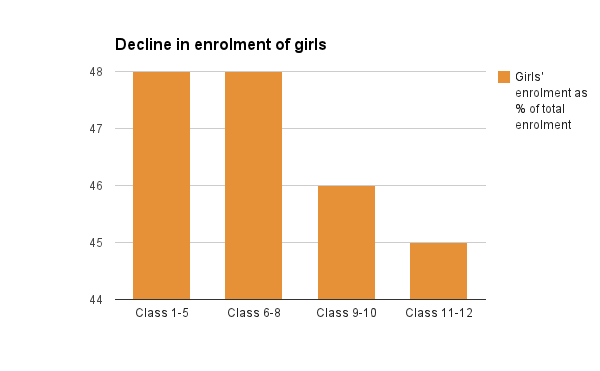
(Source: CBSE annual reports)
The same trend is noticeable in the performance of students in CBSE Class 10, where pass percentages differ only by a percentage point or less.
Girls are outstripping boys despite the enormous odds they must brave to get an education. While the number of girls in primary schools is more or less equal to that of boys, that figure declines in secondary school, and by Class 12, girls form only 45% of the school-going population
“Girls start to lag behind boys in terms of enrolment once they are about 14 years of age,” said Madhav Chavan, founder of Pratham, an NGO that has surveyed schools across the country since 2005. Because there are fewer secondary schools than primary schools, as students grow older, educational facilities get farther away from them. While this is not a deterrent for boys, it is for girls.
The poor quality of sanitation facilities in schools also deter girls from enrolling in secondary schools.
Despite this, those girls who do make it to Class 10 and beyond clearly outstrip boys. Girls are forced to perform better because if they don't, their parents will not invest in their higher education, suggested Siti Giri, who works for an Indian education company.
Another factor at play could be that in poor communities, boys are drawn into wage labour fairly early, said Nandini Manjrekar, a professor of education at the Tata Institute of Social Sciences. "Young women also see in education the prospect of increasing their own status in terms of identity and self-respect," she said. "They want to enter the paid workforce."
But the more important question, according to her, was, what happened to these girls after they graduated Class 12.
Less than half of the girls who attend secondary school actually make it to tertiary institutions, despite the fact that more of them graduate secondary school.
This represents a waste of potential in spite of the greater push for education for women.

(Source: CBSE annual reports)










